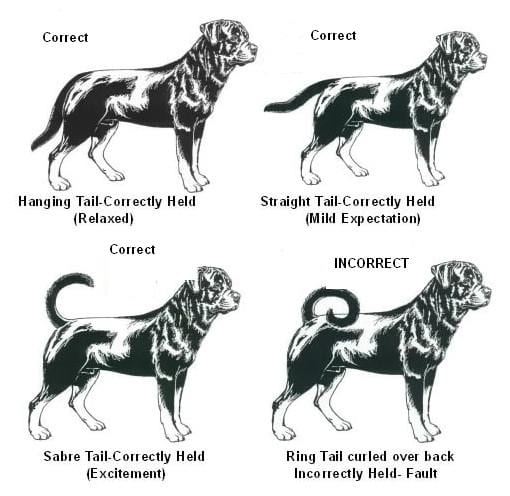One of the primary methods by which a dog communicates is through their tail and as a result, we are aware of their moods and emotions. Their emotions range from fear, hostility, and aggression on one hand, to playfulness and friendliness on the other. We love a dog as much for their hyperactive tail as for their appealing face. In recent times, a long-tailed Rottweiler is considered more appealing and the right specification for the breed.
Rottweiler tails usually hang while at rest and stand over the back when keyed up. Rottweilers’ tails have been shortened or ‘docked’ since the 19th century as they became popular in Germany. In the US this ultimately became the standard for the breed and the Rottweiler tail is now “docked short, close to the body.” Under American standards, the set of the Rottweiler’s tail assumes more importance than the length.
READ: Docking A Rottweiler’s Tail: AKC Says Yes But Should You Go For It?
At present docking of the Rottweiler’s tail is considered pointless and a cause of unnecessary pain to the dog. The ADRK, the German Rottweiler Club now regards a long-tailed Rottweiler as the standard for the breed.

Rottweiler tails were docked for several reasons but the modern rationale for docking is primarily about appearance. Some owners feel that a Rottweiler’s tail acts more as an impediment in such an excessively active and physical breed. For instance, as a guard dog, there is the danger of their tail being grabbed. Some believe that it comes in the way of intense physical activity, something which the Rottweiler is accomplished in and loves. A third reason is hygiene; the tail gets into the nastiest of places and usually ends up as the dirtiest part of the dog at the end of the day. But these are not adequate reasons for mutilating a magnificent breed!
A Long-Tailed Rottweiler Is No Less Aggressive
Docking a Rottweiler’s tail for hygiene or to prevent injuries may be justified. But the reason put forward that a Rottweiler with a docked tail is more aggressive is unfounded. It was once assumed that docking the Rottweiler’s tail gave strength to their back, allowed them to run faster, and prevented rabies.
A full and natural tail does not in any way affect the natural behavior of a Rottweiler or their physical abilities. So we may safely assume that cutting off a Rottweiler’s tail is purely about appearance.
A long-tailed Rottweiler’s balance, agility, and speed are not affected and docking does not enhance these abilities in any way.
A Means Of Communication

A dog’s primary means of communication is their tail. Every emotion that a Rottweiler feels is conveyed through it. The way that a Rottweiler moves their tail conveys emotions from happiness to aggression and fear. Many attacks are a result of an incorrect reading of the mood of a Rottweiler. The subtle difference between fear, a defensive frame of mind, and aggression can be detected by looking at the position of the tail.
READ: 10 Different Ways Your Rottweiler Can Stare At You And Its Meaning
The United States has no obligation to join in and considers a short tail or docked tail as the standard. But several nations have banned docking for reasons other than purely in the interests of the dogs’ welfare. It is banned in almost 40 countries and the RSPCA is opposed to it. Today most Rottweilers are service or companion dogs rather than working dogs. So a natural long-tailed Rottweiler can in many ways be considered a truer representative of this magnificent breed.


